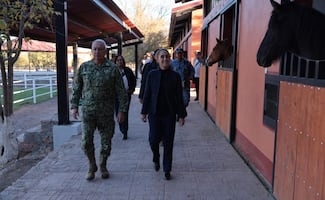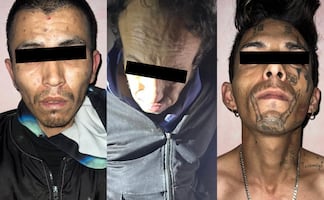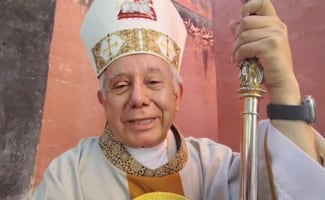Más Información

Padres y normalistas de Ayotzinapa marchan en Chilpancingo; acusan impunidad por asesinatos y la desaparición de los 43

Sheinbaum reconoce labor de las Fuerzas Armadas; hombres y mujeres que entregan su esfuerzo y su vida por amor al pueblo, destaca

Trump minimiza nuevas fotos con el pederasta Epstein publicadas por el Congreso; "no son gran cosa", dice

Recuperado, Ealy Ortiz retoma su liderazgo en EL UNIVERSAL; encabeza comida de fin de año de la empresa

Localizan a Yareth Alexandra, joven de 17 años privada de la libertad en Tecámac; la tenían escondida en una bocina
In Mexico , pregnancy termination is a practice that has been documented since ancient times. For example, during the pre-colonial times, around 150 women impregnated by Moctezuma Xocoyotzin , the last Tenochtitlan governor, were forced to have an abortion for political and social interests.
Nevertheless, abortion was severely punished.
In her book Abortion in Mexico , anthropologist Margarita Nolasco writes: “In Mexico , all Indigenous groups knew about abortion practices and used them at some point,” the technique used “can be called mechanical, such as hitting the stomach, the ingestion of concoctions that were more or less effective, as well as many other resources.”
Nevertheless, in order to understand what abortion implied to the Mexica inhabitants, it is necessary to understand how they perceived life and death . The Mexicas focused on nature and its changes and built its position before the universe on that basis.
In his book Death Among the Mexicas , Eduardo Matos explains that “the presence between day and night, cold and hot, being born and dying, are only a few realities that take (human) to live inside a world of dualities that are their own.”
Moreover, in his article “ Birth in the Pre-colonial World ,” Ernesto de la Torre says that “the state and society were interested in the viability” of the pregnancies and even favored the child over the mother's life. If the woman died during childbirth , she was called “ mocihuaquetzque ,” brave woman.
In regards to sexuality , in Women and family in Mexica Society , María De Jesús Rodríguez explains that sexuality was conditioned by the government and that Mexicas used their ideological system to lead “ feminine procreation in the desired direction, according to the circumstantial needs present in the economic structure.”
Furthermore, women were forced to be celibates until marriage and extramarital affairs were also forbidden, what is more, Mexican women were forced the first men who expressed interest because if the woman refused, they could be sexually abused by the man they rejected.
According to María de Jesús Rodríguez, “women were taught that their most important role in life was maternity ; they were made to believe that the gods had created them to birth warriors to enhance the lordship;” therefore, sterility was seen as a divine punishment .
In Body and Ideology, Alfredo López Austin explains that in Tenochtitlan , the empire was founded in the “exploitation of tributary groups,” therefore, their policies promoted the idea that couples had to marry at a young age and have several children.
This way, “every time a ' macehuall ' got married, he was registered as a tributary . Maternity was not only promoted, but it was also imposed,” said María Rodríguez-Shadow and Lilia Campos Rodríguez , experts on g ender archeology on their book Gender and Sexuality in Ancient Mexico .
In an agricultural and warrior society, reproducing was a mandate and as a result, abortion was criminalized. Rodríguez-Shadow and Campos Rodríguez establish that “all the practices that didn't contribute to the population growth were punished with death: lesbianism , induced abortion , infanticide , among others,” yet there are records that show that that abortion was still practiced.
How much does an abortion cost in Mexico?
Abortion was allowed to the rich and powerful
In her book The Aztec Woman , María J. Rodríguez-Shadow , a doctor in anthropological sciences , explains that “In Tenochtitlán , induced abortion was considered as a serious crime ,” for this reason, “abortive practices were punished with the death penalty not only for the user but also for the healer who induced it.”
In contrast, abortion was allowed to the concubines or secondary wives of governors because there “were difficulties for their (illegitimate) children to inherit privileges.”
Historian Alfredo López Austin says that Moctezuma Xocoyotzin impregnated 150 women who were forced to have an abortion “because the number of children represented serious problems for nobility rights .”
Doctor Austin López also explains this particular case “can be considered exceptional and justified for political reasons that went beyond legal and moral reasons.”
Abortion during pre-colonial times
During pre-colonial times midwives , known as " ticitl ," had a significant role as they were considered health experts and were recognized for their work before, during, and after childbirth .
The attention provided by the midwives included herb concoctions , rituals , surgeries , and medicinal baths , according to Ericka García , Dulce María Guillen , and Margarita Acevedo in their article “ Humanism During Childbirth .”
In their book Witches, Midwives, and Nurses , Barbara Ehrenreich and Deirdre English talk about the history of women in health. They consider that women have always been healers and that they “knew how to induce abortions and were nurses and advisers. Women were the first pharmacologists with their medicinal herbs crops, passing down their secret used to one another.”
During pre-colonial times , Temazcalteci , the goddess of medicinal herbs was venerated. According to Bernardino de Sahagún , Mexicas venerated “doctors, surgeons, and also midwives and those who provided herbs to abort.”
According to Axayacatl Cuevas Coeto , an agronomy engineer and expert on herbal medicine , the Dioscorea mexicana was used to induce abortions before the Spanish colonization .
The barbasco species belongs to the Discorea genre and was “used by midwives or women to look after the pregnancy and birth but in large doses, it induced abortion . Through observation, practice, and experimenting, women realized it,” Axayacatl Cuevas said.
Furthermore, according to expert Nina Hike , there are different species but the Dioscorea mexicana , also known as Mexican yam , has been used as the main material in the synthetic steroid hormones industry.
In Hike's article “ Barbasco ,” it is one of the lesser-known plants yet it is one of the most important ones for the pharmaceutical industry in the production of contraceptives .
On the other hand, rue, also known as Ruta graveolens , is one of the plants used to induce abortion ; nevertheless, Cuevas Coeto explains that this plant arrived in Mexico from Europe after the colonization .
Nowadays, it is possible to find these herbs in the Sonora market in Mexico City but this is a taboo topic for business owners in the market.
Axayacatl Cuevas adds that there is a large part of the population that uses herbs to cure illnesses and induce abortions : “there are towns or Indigenous communities , very marginalized , where women are the victims of rape and many of them are forced to abort through the use of these herbs” but inducing an abortion through herbal medicine can be risky: “the use of plans or drugs without supervision is dangerous and in the case of abortion, it can cause hemorrhages and even death .”
Now, 500 years later, the worldview , politics , and society have changed. In Mexico City , abortion before the 12th week was decriminalized in 2007 and more recently, this year, Oaxaca also decriminalized abortion; nevertheless, there are 30 states where abortion is still a crime, even when women's sexual and reproductive rights should be guaranteed.
gm
Noticias según tus intereses
[Publicidad]
[Publicidad]









